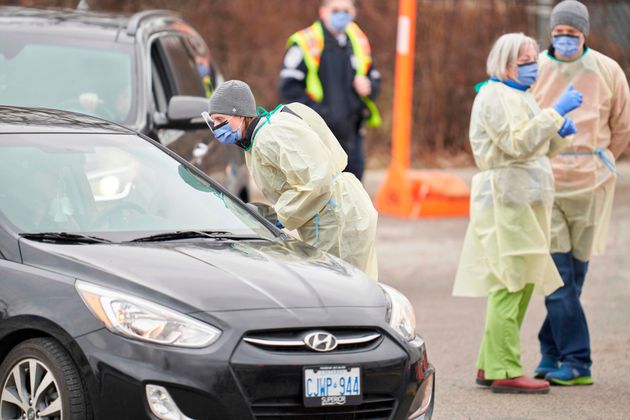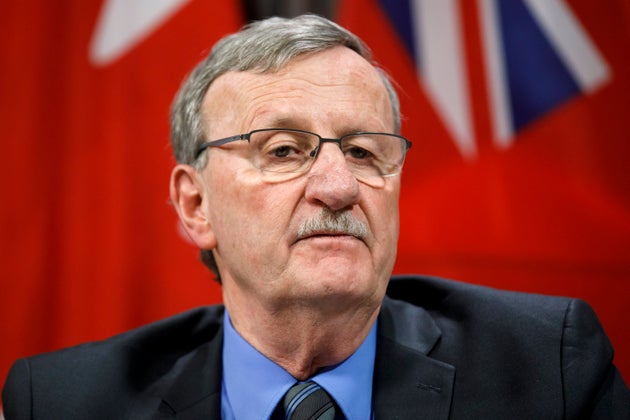
Health care workers speak with patients at a drive-thru Covid-19 assessment centre in London, Ont.
The province is sending about 3,500 tests to its labs every day, even though labs can accommodate 13,000 tests
Conservative Leader Andrew Scheer said today he has no plans to resign, and vowed instead to stay at the helm of his party and take another swing at defeating Prime Minister Justin Trudeau in the next election.
Ontario’s overly cautious approach to COVID-19 testing is endangering lives and hindering efforts to rein in soaring infections that are ravaging long-term care facilities, filling ICU beds and lurking silently in communities, say critics alarmed by the province’s admission that labs can handle nearly four times the number of tests they receive.
Dr. Camille Lemieux, chief of family medicine at the University Health Network, expressed frustration Wednesday over revelations the province has been sending roughly 3,500 tests a day to its labs of late, even though labs can accommodate 13,000 tests.
“You can’t make decisions in the dark, and you can’t make decisions based upon what you don’t know and I think any reasonable person would say that,” says Lemieux, who works out of downtown Toronto’s Western Hospital where she’s also the medical lead for the facility’s assessment centre.
“Ontario in my opinion is making decisions in the dark and making decisions based upon what they don’t know.”
Lemieux says doctors knew for weeks that testing rates fell short of growing lab capacity, but had no idea the gap was this large.
Even though community assessment centres are told on the one hand to use their clinical judgment to administer COVID-19 tests, she says doctors are also told to adhere to provincial criteria. Currently, that includes testing people who have symptoms and also fall into prioritized groups, which include health-care workers, travellers and long-term care residents and staff.
“We occasionally get people walking in because of course, we’re a storefront, and those people are unfortunately frequently told ‘No, we will not test you,’ despite having symptoms or a high suspicion on our part that they’re COVID positive,” she says.
“I can’t describe to you the level of frustration that puts on those of us who are working and really want to be testing more broadly.”
Less than two weeks ago, Ontario was buckling under a huge backlog that hovered near 11,000.
At the same time, lab capacity ramped up considerably with private players including Life Labs joining public efforts to document growing cases.
Public health officials acknowledged Tuesday that lab capacity has grown significantly and that the push is now to get community assessment centres to permit more people to take the test.

“The capacity issue isn’t what it was — they should be testing,” Dr. Barbara Yaffe, Ontario’s Associate Chief Medical Officer of Health, said of guidelines that restrict tests, even for some who display COVID-19 symptoms.
“We’re also looking at more testing in facilities where there’s an outbreak, more testing with health-care workers as appropriate, in Indigenous communities and so on, and there’s an expert group that’s going to be reporting very shortly (on) testing strategy…. We don’t want to go overboard and end up with another backlog.”

Ontario’s chief medical officer of health, Dr. David Williams, said the fewer tests seems to coincide with fewer people using the province’s telehealth service and its online assessment tool, which tells people whether they meet the criteria for COVID-19 testing.
“It may be evidence of some flattening,” he suggested, admitting he preferred to “be optimistic” in believing it could be due to fewer travellers and fewer people with symptoms.
“We’re not trying to limit (testing),” he insisted.
Williams cautioned that testing too widely would produce “biased” data that skew too heavily towards negative results when the goal is to reflect the population-at-large.
He also said global demand for testing and laboratory supplies is still high, requiring continued rationing, even as criteria is expanded.
“Sometimes these things ebb flow and we could get into another surge again. And if you compromise yourself — so you used up your reagent and your swabs and your supply — someone would ask at that time of the crucial need again: Why are you not more vigilant and cautious in your use of those supplies?” said Williams.
Tara Moriarty, an associate professor in the University of Toronto’s faculty of medicine who started a petition calling for increased testing capacity, said this step is crucial to suppressing COVID-19′s spread and its impact on the health-care system.
“The ramifications of this delay in testing scale-up is enormously problematic for the most at-risk populations, seniors in assisted living and LTC homes. Testing should have been massively scaled up there last week,” says Moriarty.
“This is a big problem.”
Speaking to reporters in Regina this morning, Scheer said he had hoped for better results but is happy with the “significant gains” the Conservatives achieved in this election.
“We point to the fact that we won the popular vote, a million more votes for our party last night than than ever before, and that we have the strongest opposition in Canadian history,” Scheer said. “More people voted for me and the Conservative platform than any other party.”
The party won roughly 300,000 more votes last night than its previous best, in 2011 — not the 1 million Scheer cited.
“This was the first step in a process to replace Justin Trudeau’s government … we’ll take the next few days to prepare the ground work for the next campaign. We’ll continue to prepare and fight for when the government falls,” Scheer said.
Scheer managed to bolster his party’s popular support thanks in part to lopsided victories in Alberta and Saskatchewan, where the party achieved record results.
Despite a promising start to the campaign in Quebec, the Conservatives actually lost seats in that province.
The party emerged as a starkly more regional entity, with its support largely concentrated in Western Canada. There, the party’s base turned out in record numbers, thanks in part to hugely unpopular Liberal policies that are seen as constituting an attack on the country’s oil and gas sector.
While Scheer promised to stay on as leader, the choice ultimately rests with the Conservative Party membership.
Under the party’s constitution, if it fails to form a government — and if the leader has not yet formally signalled an intention to resign — then delegates can vote at the next party convention to hold a leadership race.
The party launches a leadership race if more than 50 per cent of members at the party convention vote in favour of one. The next Conservative convention happens in 2020.
The Conservatives faltered in the rest of the country, failing to make significant inroads in Atlantic Canada, Quebec or Ontario.
In fact, the Conservative Party won more votes in Alberta alone than it received in Quebec, New Brunswick, Prince Edward Island, Nova Scotia and Newfoundland and Labrador combined.
Compared to 2011, when the Conservatives won a convincing majority government, the party achieved lower popular vote support levels in every province except Alberta and Saskatchewan.
In once solidly blue ridings like Central Nova and South Shore-St. Margaret’s in Nova Scotia, and Milton in Ontario, the Liberal candidates easily bested their Tory opponents.